#SaltwaterWitch
Text
This beautiful bird landed in the yard today. I'm guessing a Northern Goshawk?
24 notes
·
View notes
Photo

Salt is one of the most powerful cleansing + healing agents on Earth. That includes Sea/Ocean water, Sweat & Tears. Sometimes you need all three to really work through an issue. 🙏🌊 😭🏃💦💙⚝🌛🌝 🌜
#magicalsaltwater#saltwater#saltwater witch#saltwaterwitches#seawitch#ocean witch#witch#witchy#witches#witchcraft#modernwitch#modernwitches#modernwitchsguidetolife
18 notes
·
View notes
Photo

❤ 15 likes
saltwaterwitch: it too hot. even at #dawnpatrol
3 notes
·
View notes
Text

Well, that worked pretty well for an 88% waxing moon with the ZWO ASI071MC color camera. The near-full moon and Jupiter at opposition were just far enough away to make this set up work--plus a lot of 5-minute exposures. That band of red at the top left is the tail end of the ridge of hydrogen that runs behind the Horsehead Nebula (B33). Imaging notes: 63 x 300-second subs, no filters with the ZWO ASI071 color camera cooled to 0C, William Optics RedCat 15 Apo refractor, Sky-Watcher EQ6-R Pro mount. The Orion Nebula (M42), Running Man Nebula (Sh2-279), De Mairan's Nebula (NGC 1982,M43), and surrounding nebulosity.
More of my astro stuff here: https://SaltwaterWitch.com
32 notes
·
View notes
Text
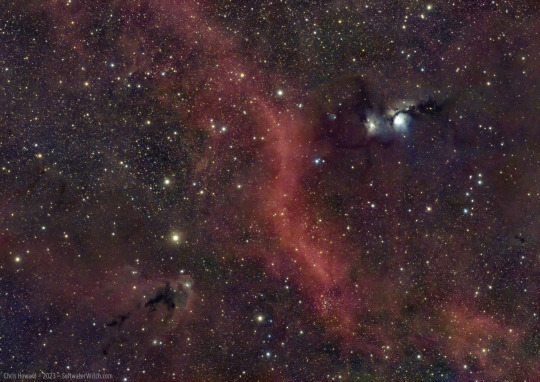
Astrophotography from my backyard--from last night's imaging run: M78, LDN 1622, and a piece of Barnard's Loop. Top right is a structure composed of a batch of dark nebulae clustered around the reflection nebula Messier 78 (M78, NGC 2068), about 1,350 lightyears away, and bottom left is LDN1622, the "Boogeyman Nebula" about 500 lightyears away. And the wide ribbon running between them, mostly ionized hydrogen and interstellar dust, is part of "Barnard's Loop", which runs around the Alnitak side of the constellation Orion.
Imaging Notes: 49 x 300-second subs taken with the ZWO ASI071MC color camera (cooled to 0°C, gain 0) and the William Optics Redcat 51 apochromatic refractor (250mm FL, f/4.9), Sky-Watcher EQ6-R Pro mount, ZWO ASIAir Plus astro controller. I shot 94 sub-expsures at 5-minutes each, starting around 7pm and running through the night to about 4am, but ended up tossing almost half of them, stacking the best 49.
https://SaltwaterWitch.com
12 notes
·
View notes
Text

A beautiful cluster of spiny brittle stars (Ophiothrix spiculata?), shot with my iPhone on a trip to Monterey Bay Aquarium in 2013.
7 notes
·
View notes
Text

The Heart Nebula on the right (IC 1805, Sharpless 2-190) and Soul Nebula, left, (Westerhout 5 with the star cluster IC 1848) in Hydrogen-alpha. These two make up a massive star-forming complex in Cassiopeia about 7500 lightyears away in the Perseus Arm of our Galaxy. The bright emission nebula on the far right is the Fishhead Nebula (NGC 896, IC 1795). The small circular cloud, middle top, is another emission nebula Sh2-198, much further away, around 18,000 lightyears (still, well within the galaxy). The bright cluster of stars in the core of the Heart Nebula is Melotte 15.
Imaging Notes: 51 x 5-minute exposures stacked in PI, ZWO ASI2600MM-Pro monochrome camera cooled to -10C, 3nm Antlia Pro Hydrogen-alpha filter, William Optics SpaceCat 51 apo refractor, Sky-Watcher EQ6-R Pro mount. Shot from my backyard in coastal New Hampshire, bortle 4-ish.
https://SaltwaterWitch.com
#saltwaterwitch#astrophotography#astronomy#backyard astronomy#narrowband imaging#zwo#nightsky#universe
6 notes
·
View notes
Photo

The Ghost of Cassiopeia - Let's start with that big star, Gamma Cassiopeiae (γ Cassiopeiae) or just "Gamma Cas" and sometimes "Navi" is the center star in the "W" asterism that makes up the constellation Cassiopeia, one of the easiest constellations to find in northern hemisphere skies. It's an eruptive variable star—which sounds exciting for a star; this basically means it is unpredictably variable, with an apparent magnitude between 1.6 and 3, and does not follow an observed repeatable cycle. The two nebulae IC63 ("Ghost Nebula", below γ Cass in this rotation) and IC59 (above) are fairly dim, but do reflect light from γ Cass and other nearby stars, and IC63 exhibits some emission properties, gaining energy and then emitting it as light. Gamma Cas and both nebulae are about 550 lightyears away, very close to us. In terms of distance from Earth, this is one of the closest Deep Sky Objects I have ever captured, and M45, the Pleiades, at around 450 lightyears may actually be the closest. Imaging Notes: 93 x 180-second subs across Red, Green, Blue filters (Astronomik Deep Sky RGB), ZWO ASI1600MM-Pro monochrome camera running at -10C, ZWO AM5 EQ mount, William Optics SpaceCat 51 apochromatic refractor, ZWO ASI290MM guide camera with OAG.
36 notes
·
View notes
Photo
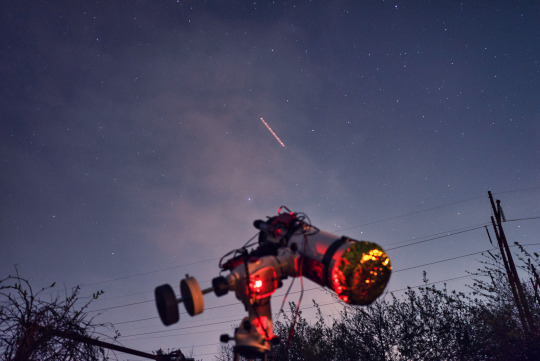
An 8 second exposure of my astro setup during last night's imaging run, shot in the backyard with the Sony A7s and Zeiss Batis 25mm f/2 lens. The skies weren't very clear, with patchy clouds sliding by and overall poor seeing (astronomical seeing represents the impact of atmospheric turbulence), but still managed to capture Messier 5 in the constellation Serpens.
10 notes
·
View notes
Text
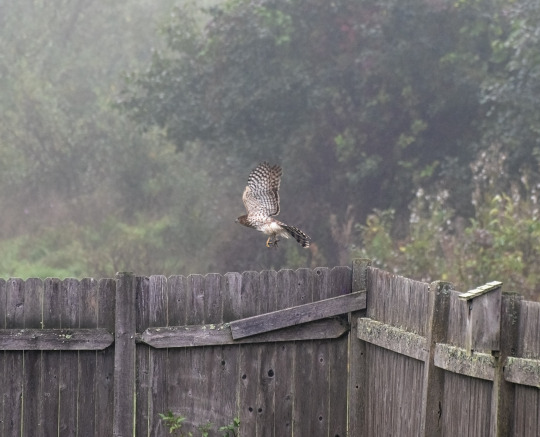
Cooper's Hawk in the backyard, didn't like me walking out with the Nikon D750, 300mm.
2 notes
·
View notes
Photo
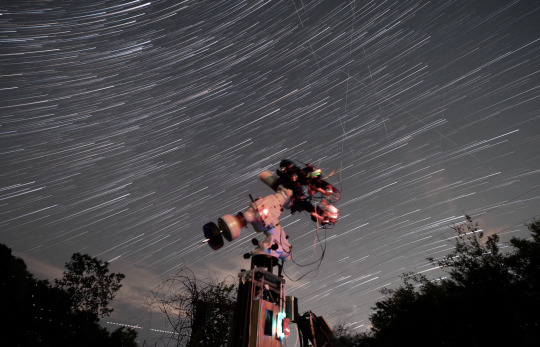
Several stacked frames from a set of time-lapse images I shot last week, showing my dual-scope setup, narrowband and RGB color.
https://saltwaterwitch.com
4 notes
·
View notes
Text
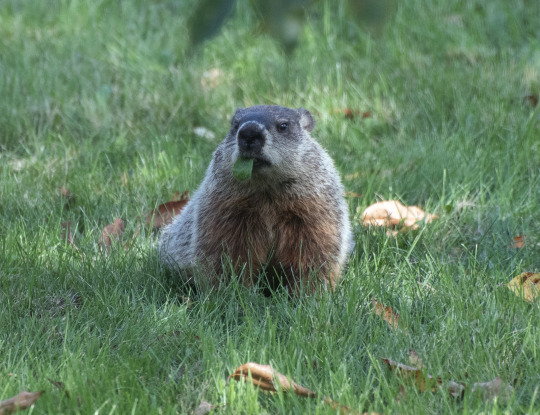
Our backyard groundhog, Suzy, is out and about today. She lives under the shed and is basically the queen of the entire fenced-in area, a good half acre or so.
2 notes
·
View notes
Photo
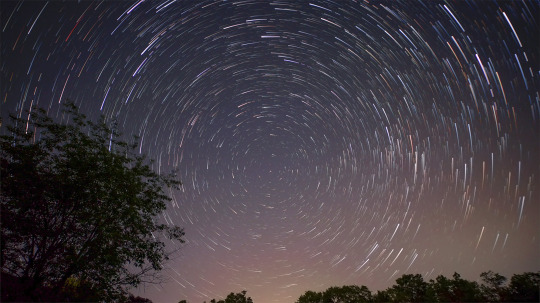
A star trails view of the NCP (North Celestial Pole) from my backyard, five hours of 15-second exposures stacked together to show the Earth's rotation. That star in the middle is the North Star, Polaris, the star at the end of the handle in the Little Dipper asterism. Polaris is very close to the NCP, only 4 degrees off the actual point in space that marks our planet's North Celestial Pole. Basically, if you're standing in a fixed position on the surface (say, in coastal New Hampshire at around 43° latitude) and draw an imaginary line along Earth's axis of rotation, out into space, until you reach a single point in space--that's the celestial pole, and from your perspective, all stars will rotate around that point. In the southern hemisphere, looking south, you have the SCP, South Celestial Pole, which doesn't have a bright star in close proximity--so imagine this image without that bright point of light in the center.
What is also interesting in this image, and makes it really clear, is that stars have color. Blue stars "burn" hotter and faster, redder stars are generally cooler and longer-lived. Our star, the Sun, is somewhere between, a medium-sized main sequence star about halfway through its 11-billion-ish year lifespan.
Notes: 1104 x 15-second exposures, Sony A7s, Irix 15mm f/2.4 lens, stacked in StarStax.
3 notes
·
View notes
Text

First Light with the ZWO ASI2600MM Pro mono camera
June and July consistently delivered terrible weather for astronomy. There was one clear-ish night somewhere in the middle of the waves of thunderstorms, torrential rain, and general cloudiness, but there was a nearly full moon, and a few hours of clear skies amid weeks of cloud wasn’t worth it. So I waited for the next opportunity. Last night, August 11th, I set up the Sky-Watcher mount with the William Optics SpaceCat and the new camera.
Here's the result of my first imaging run with the ZWO ASI2600MM Pro mono camera, cooled to -10C, Antlia 3nm Hydrogen-alpha Pro Imaging filter (2 inch). 52 x 300-second sub-exposures with minimal calibration (bias & dark, no flat frames). The ASI2600 is built around the monochrome version of the Sony IMX571 APS-C sized sensor, and although you can get away with 36mm unmounted filters, I went all the way to 2 inch mounted narrowband filters. And not even a hint of vignetting. I didn't use flat frames when stacking. So, am I impressed with the ZWO ASI2600MM Pro? Oh yeah.
I started narrowband imaging about ten years ago with Atik mono CCD cameras, moved through a couple QHYs, and settled on the ZWO ASI1600MM Pro—the smaller, older generation of this ASI2600. I've been using the 1600 for four or five years, and it was time to upgrade. The 2600 has been out for a little while—I'm not new to this camera but I'm really glad I made the jump.
Target Notes: NGC 7822, Cederblad 214, SH2-171 (the brighter emission nebula core) as well as the star cluster Berkeley 59. There are several long chains of clumps of dark nebulae, including LDN 1268, 1275, Dob 3637, 3627, 3623, many more. Nestled in that large band of dark nebulae toward the bottom is the reflection nebula GN 23.56.1. The very small circle of gray at the top left, blending in but dimmer than the nearby stars, with less contrast, is the planetary nebula Abell 1 (PLN 119+6.1). Find all of this—the nebulae and star forming complex in Cepheus near the edge of Cassiopeia.
3 notes
·
View notes
Text
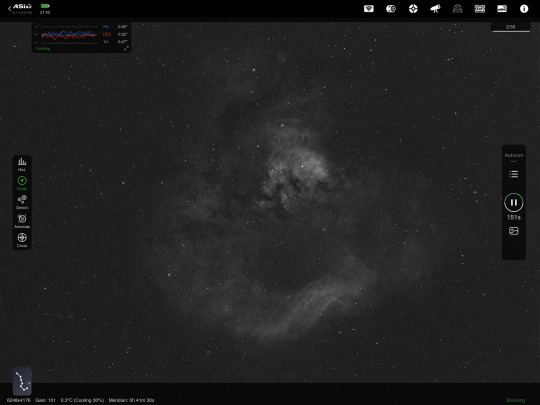
First light with the new ZWO ASI2600MM Pro cooled monochrome camera, with a single 300-second sub of NGC 7822, Cederblad 214, SH2-171 (the brighter emission nebula core) as well as the star cluster Berkeley 59. This is a screenshot of the ASIAir app running on my iPad.
2 notes
·
View notes
Text
Building Worlds without Becoming the Minister for Tourism
New post: Building Worlds without Boring your Readers or Becoming the Minister for Tourism (Originally published in Now Write! Science Fiction, Fantasy and Horror, Penguin 2014)
https://www.patreon.com/posts/build-worlds-for-86806251
3 notes
·
View notes